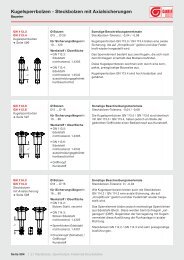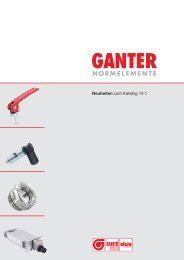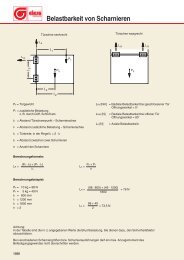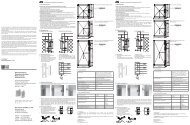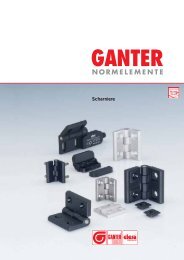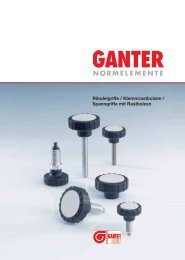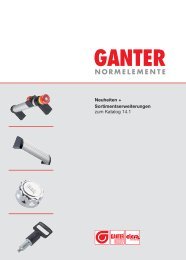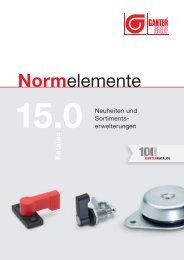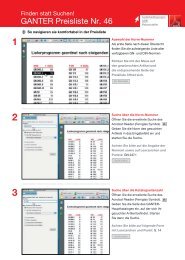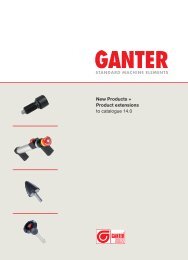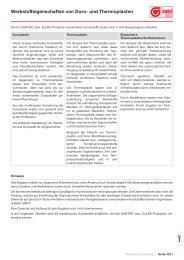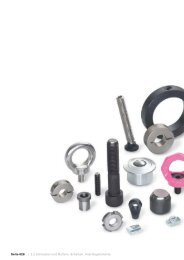Material characteristics of Duroplast and Technopolymer - Ganter Griff
Material characteristics of Duroplast and Technopolymer - Ganter Griff
Material characteristics of Duroplast and Technopolymer - Ganter Griff
Create successful ePaper yourself
Turn your PDF publications into a flip-book with our unique Google optimized e-Paper software.
®<br />
<strong>Material</strong> <strong>characteristics</strong> <strong>of</strong><br />
<strong>Duroplast</strong> <strong>and</strong> <strong>Technopolymer</strong><br />
The plastic materials used for GANTER / ELESA products can be classed in three main groups:<br />
<strong>Duroplast</strong><br />
This group includes plastic materials which solidify by chemical reactions. They closely crosslink into spatial lattice patterns<br />
<strong>of</strong> macromolecules which gives <strong>Duroplast</strong> material high mechanical strength <strong>and</strong> surface hardness. Their eleasticity<br />
is low, however.<br />
The curing process is irreversible. Unlike <strong>Technopolymer</strong>, <strong>Duroplast</strong> cannot be melted because it is rigid up to degradation<br />
temperature. Phenolic resins are among the most commonly used <strong>Duroplast</strong> materials.<br />
In general, the molecular crosslinking <strong>of</strong> <strong>Duroplast</strong> creates good chemical stability.<br />
The colouring <strong>and</strong> dyeing options <strong>of</strong> components made <strong>of</strong> <strong>Duroplast</strong> are limited.<br />
<strong>Technopolymer</strong><br />
With increasing temperature <strong>and</strong> once the s<strong>of</strong>tening point is exceeded, this group <strong>of</strong> technopolymer melts, can be heat<br />
distorted <strong>and</strong> solidifies again after cooling. This process can be repeated any number <strong>of</strong> times. Unlike <strong>Duroplast</strong>, there<br />
is no chemical reaction during processing.<br />
<strong>Technopolymer</strong> materials can be subdivided into amorphous <strong>and</strong> partially crystalline plastics. The disordered structure<br />
<strong>of</strong> amorphous materials allows the production <strong>of</strong> transparent components by injection moulding right through to crystalclear<br />
parts. Partially crystalline thermoplastics have a structure resulting in enhanced mechanical properties <strong>and</strong> temperatures<br />
<strong>of</strong> use.<br />
The wide variety <strong>of</strong> different technopolymers <strong>and</strong> the options <strong>of</strong> modifications allow the production <strong>of</strong> ªtailor-madeº construction<br />
tools with respect to mechanical properties, chemical resistance, temperature resistance <strong>and</strong> different colours.<br />
Elastomers / Thermoplastic Elastomers<br />
The group <strong>of</strong> elastomers includes materials which can be stretched <strong>and</strong> bent without exerting great force. Once the<br />
deforming force relaxes or no longer acts at all, the parts take their original shape.<br />
In chemical terms, these are macromolecules which are interconnected by only a few chemical crosslinking bridges.<br />
By way <strong>of</strong> modification, elastomers can be made in varying degrees <strong>of</strong> hardness. They can be dyed easily by adding<br />
colour pigments.<br />
Note<br />
The above details are general values without claiming to be complete. <strong>Material</strong> properties may vary widely through<br />
additives, modifications <strong>and</strong> environmental influence factors.<br />
The details are unsuitable as the sole basis for constructions. The data may not be used in place <strong>of</strong> tests to determine<br />
the suitability <strong>of</strong> a material for a specific purpose.<br />
Reference is made at this point to the mechanical strength values <strong>of</strong> various plastic products which have been determined<br />
by tests.<br />
No warranty or liability will be accepted fort he above specifications <strong>and</strong> details.<br />
The essential plastic materials used for GANTER / ELESA products are listed in the tables below.<br />
897
Symbol<br />
Description<br />
Specimen condition<br />
Yield stress<br />
Tensile strength [M Pa] 1 )<br />
Tension-E-module [M Pa] 1 )<br />
Ball indentation hardness<br />
[M Pa] 1 )<br />
Temperature resistance:<br />
max. short-term<br />
max. longer-term<br />
min. temperature in use<br />
Resistance to:<br />
Oil, grease<br />
Solvents (Tri / Per)<br />
Acids (strong / weak)<br />
Alkalines (strong / weak)<br />
Petrol<br />
Alcohol<br />
Hot water<br />
UV light/weather exposure<br />
Fire behaviour (UL 94)<br />
General:<br />
898<br />
®<br />
<strong>Material</strong> <strong>characteristics</strong><br />
<strong>of</strong> <strong>Duroplast</strong> <strong>and</strong> <strong>Technopolymer</strong><br />
<strong>Duroplast</strong><br />
PF 31<br />
Phenolie resin<br />
±<br />
±<br />
60<br />
9000<br />
250<br />
180° C<br />
140° C<br />
±<br />
+<br />
o<br />
+/±<br />
+/±<br />
+<br />
+<br />
o<br />
±<br />
V-0<br />
This <strong>Duroplast</strong> material<br />
on phenolic resin<br />
basis with organic filler<br />
has the following properties:<br />
high stiffness<br />
<strong>and</strong> hardness, low tendency<br />
to creep, high<br />
heat forming resistance,<br />
low thermal linear<br />
expansion, high surface<br />
slip resilience,<br />
low flammability.<br />
Phenolic resins are<br />
available only in dark<br />
colours shades. They<br />
are not suitable for use<br />
with food.<br />
Typical applications<br />
include thermally<br />
insulating operating<br />
elements.<br />
PA 6<br />
Polyamide<br />
dry / air humid<br />
80 / 50<br />
±/±<br />
3000 / 1500<br />
150 / 70<br />
180° C<br />
90° C<br />
± 40° C<br />
+<br />
+/+<br />
o/±<br />
+/o<br />
+<br />
+<br />
o<br />
o<br />
HB<br />
<strong>Technopolymer</strong><br />
PA 6 GF30<br />
Polyamide<br />
with 30 % glass fibre<br />
dry / air humid<br />
±/±<br />
180 / 110<br />
9000 / 6500<br />
220 / 150<br />
200° C<br />
120° C<br />
± 40° C<br />
+<br />
+/+<br />
o/±<br />
o/±<br />
+<br />
+<br />
o<br />
o<br />
HB<br />
PA 6-T<br />
Polyamide<br />
transparent<br />
±<br />
90<br />
±<br />
2800<br />
140<br />
130° C<br />
90° C<br />
± 7 0° C<br />
+<br />
+/+<br />
±/±<br />
+/+<br />
+<br />
±<br />
±<br />
o<br />
The material group including polyamide 6 (partically drystalline) <strong>of</strong>fers<br />
all-round materials for mechanical function components in mechanical<br />
engineering.<br />
Polyamides are:<br />
Cold-temperature resistant<br />
Impact stress resilient <strong>and</strong> impact resistant<br />
Abrasion resistant<br />
Reinforced polyamides such as PA 6 GF30 combine high stiffness <strong>and</strong><br />
rigidity with extreme impact strength, properties which make them highly<br />
robust under mechanical stress.<br />
Polyamide 6-T (amorphous) is translucent with a slightly yellow transparency<br />
parent. Typically used for oil-level sight glass.<br />
1 ) MPa = Megapascal + resistant o conditionally resistant ± non-resistant<br />
V-2
Symbol<br />
Description<br />
Yield stress<br />
Tensile strength [M Pa] 1 )<br />
Tension-E-module [M Pa] 1 )<br />
Ball indentation hardness<br />
[M Pa] 1 )<br />
Temperature resistance:<br />
max. short-term<br />
max. longer-term<br />
min. temperature in use<br />
Resistance to:<br />
Oil, grease<br />
Solvents (Tri / Per)<br />
Acids (strong / weak)<br />
Alkalines (strong / weak)<br />
Petrol<br />
Alcohol<br />
Hot water<br />
UV light/weather exposure<br />
Fire behaviour (UL 94)<br />
General:<br />
®<br />
<strong>Material</strong> <strong>characteristics</strong><br />
<strong>of</strong> <strong>Duroplast</strong> <strong>and</strong> <strong>Technopolymer</strong><br />
PP GF20<br />
Polypropylene<br />
with 20 % glass fibre<br />
33<br />
±<br />
2900<br />
80<br />
140° C<br />
100° C<br />
0° C<br />
+<br />
o/o<br />
+/+<br />
+/+<br />
+<br />
+<br />
+<br />
o<br />
±<br />
Polypropylenes<br />
(partially crystalline)<br />
are universal st<strong>and</strong>ard<br />
plastic materials with<br />
balanced property<br />
levels:<br />
Average strength,<br />
stiffness, impact resistance,<br />
low density,<br />
excellent chemical<br />
resistance but very<br />
bad cold temperature<br />
properties.<br />
Embedded glass fibre<br />
(e.g. PP GF20, enhances<br />
stiffness <strong>and</strong><br />
strength.<br />
Typical applications<br />
for polypropylene are<br />
fittings <strong>and</strong> armatures.<br />
PC<br />
Polycarbonate<br />
63<br />
±<br />
2400<br />
110<br />
140° C<br />
125° C<br />
± 100° C<br />
o<br />
±/±<br />
+/±<br />
±/±<br />
±<br />
o<br />
±<br />
o<br />
V-2<br />
Polycarbonates (amorphous)<br />
are translucent<br />
plastic materials with<br />
following properties:<br />
High strength, in<br />
particular high impact<br />
resistance, good<br />
optical properties<br />
self-extinguishing<br />
But:<br />
sensitive to chemicals<br />
<strong>and</strong> stress cracking<br />
not suitable for high<br />
dynamic stress loads<br />
notch sensitive at<br />
edges <strong>and</strong> corners<br />
<strong>Technopolymer</strong><br />
POM-C<br />
Polyacetal<br />
(copolymer)<br />
65<br />
±<br />
145<br />
220 / 150<br />
140° C<br />
90° C<br />
±50° C<br />
+<br />
±/+<br />
+/±<br />
+/+<br />
+<br />
+<br />
+<br />
o<br />
HB<br />
POM-H<br />
Polyacetal<br />
(homopolymer)<br />
72<br />
70<br />
174<br />
140<br />
140° C<br />
80° C<br />
±50° C<br />
+<br />
±/+<br />
+/±<br />
+/+<br />
+<br />
+<br />
o<br />
o<br />
HB<br />
Polycacetals (partially crystalline) are universal<br />
materials used in function components for precision<br />
engineering <strong>and</strong> in apparatus construction.<br />
The feature excellent properties:<br />
low friction resistance<br />
good abrasion resistance<br />
good resilience<br />
good fatigue resistance<br />
good chemical resistance<br />
Typical applications include snap-fit elements<br />
(formlocking connecting elements).<br />
1 ) MPa = Megapascal + resistant o conditionally resistant ± non-resistant<br />
899



